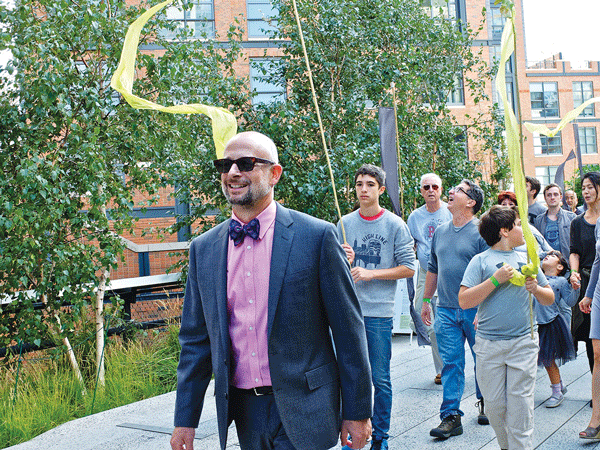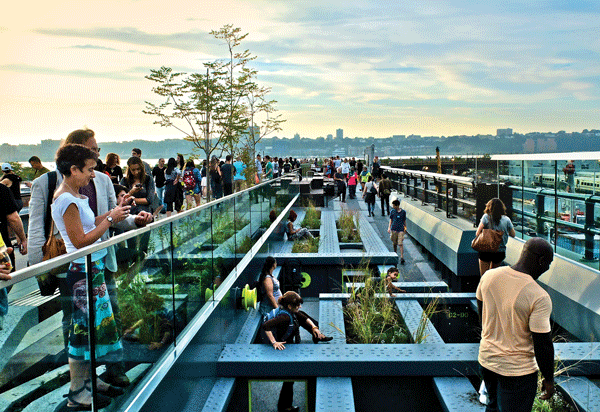
High Line enthusiasts from the world of politics and pop culture gather for Sept. 20’s ribbon-cutting ceremony — including, second from left, actor Edward Norton. Regular readers of Chelsea Now will have no trouble identifying the other players.
BY DUSICA SUE MALESEVIC | The opening of the third and final section of the High Line completes a 15-year journey started by the Friends of the High Line and the surrounding community, while beginning a new chapter for a park that forever altered the way we view industrial architecture that dots the landscape.
Joshua David, one of the Friends of the High Line’s co-founders and its current president, spoke with Chelsea Now on Thurs., Sept. 17, a few days before the weekend’s ribbon-cutting ceremonies that included puppets and a community processional on Saturday and the official opening on Sunday.
The new half-mile section, which is being referred to as the High Line at the Rail Yards, has many unique markers that distinguish it from the other two sections. The third section runs along W. 30th St. and the West Side Highway and extends to W. 34th St.
After going around a curve, as soon as people move into the third section, says David, they will be in line with the Hudson River — and privy to its beautiful vista and sunsets views in the evening.
“You have a great feeling of expansiveness and openness,” said David in a phone interview, and “there’s a big feeling of difference just in that. Whereas a lot of other parts of the High Line are interior to the blocks with buildings on both sides, you always have the streetscape open to you on one side at the Rail Yards.”
Another important distinction is the way the Friends of the High Line has treated the third section: as a found object. “The Interim Walkway is a part of the High Line that we basically left in its natural condition, the way that we found it,” said David.
When the trains stopped running, David explained, seeds that drifted there or birds that transported them to the site, sewn themselves into the gravel ballast of the High Line. Although it was an inhospitable landscape, the seeds set root and it grew into a lush natural wilderness of grasses, small shrubs and meadow flowers.

“That’s what Robert Hammond, the other co-founder of Friends of the High Line, and I first discovered some fifteen years ago when we started this project and it was the landscape that really inspired us to make a park on the High Line,” he said.
The Interim Walkway comprises about half of the new section of the Rail Yards and will offer the general public their first opportunity to see that original landscape.
Part of that scenery is seating that will is unique to this section: peel-up benches, which “sort of grow organically out of the cement planks of the High Line,” says David.
The park’s design team created one that is called the rocker, reminiscent of a seesaw, and seating called conversation benches with backs at both sides so people can face each other while sitting, David explained.
For the first time, the High Line will have a feature specifically designed for children, called the Pershing Square Beams. The cement decking that previously held up the track ballast was removed. The steel girders that make up the park’s structural form were revealed and a walkway was ramped down that will allow children to enter the grid work.

All the beams have been covered with a rubberized playground material for safety and there are a number of interactive features: speaking tubes, periscopes and something dubbed the gopher hole where children can go into the hole and then stick their head up in the planting beds.
“We’ve always wanted to have a feature designed specifically to engage the interests of children, but we’ve had a tough time finding the combination of the right site and the right design for it,” said David. “We’ve kept trying, and up at the Rail Yards we finally locked into something that we thought was the perfect design for the perfect site.”
One of the aspects that will continue in the third section is the featuring of art. Argentinian artist Adrian Villar Rojas has done an installation in the Interim Walkway. Rojas is known for large-scale forms that often use materials that change in relation to the elements. For example, fired clays that have been treated so that they react to rain or heat and change shape.

“In this case, he’s got a series of cube-like forms that are a mixture of poured concrete and soils and other organic material with seeds incorporated in them,” said David.
Rojas’ installation will remain for the year. During that time, it will have vegetation growing on it and from it, but will also in some places decay or change form.
“It’s a subtle, beautiful piece, very much in tune with the site of the Interim walkway,” said David. “It’s in this self-seeded landscape [in] which vegetation took over this monumental industrial structure and vegetation is also overtaking this artwork as well.”
Art was also on display during the processional at the opening ceremony on Saturday. David said the processional, which included several community organizations and residents, was to celebrate “the biggest moment in the High Line’s history to date, making it all the way to 34th Street” and had been designed to reflect the qualities of the community.
The High Line was a project that grew from the community and then was supported by block associations, local businesses and civic and cultural organizations.
“We wanted to mark [this] historic moment by reflecting the community investment of volunteerism and advocacy on the part of our neighbors and our community that’s made this so successful,” he said.
David credits the community with developing a strong coalition of voices that articulated its need for more parkland, and that the High Line was a great opportunity for the neighborhood and for the city at large.
The community can also be proud of the fact, he said, that it set a new global standard for the way that cities look at parks and led to the rethinking of the adaptive reuse of old industrial infrastructure. Every week, noted David, the organization gets calls from municipalities, countries, states, park organizations, civic organizations and real estate developers.
“All of whom are looking at ways to tap into some of the energy that we’ve created around the High Line,” said David, who is happy to share what they’ve learned.
Development is happening right next to the High Line, as Hudson Yards construction takes place. David said that every inch of the park has a relationship to its surrounding and there will be the shift from an open expanse next to the High Line to a dense new development with a lot of buildings.
“The High Line will provide a front row seat on one of the most dramatic urban transformation that the city has ever seen,” said David.
For the Friends of the Highline, the opening of the third section is the fulfillment of a key part of the original vision.
“To us, that’s an incredible moment to arrive at. It’s taken us fifteen years, which can seem like a long time, but it’s actually a fairly short time for a project of this scope, which faced such tremendous challenges at the very beginning,” he said.
The opening also means that there is 50 percent more park for the organization to maintain and operate. “The Friends of the High Line provides almost all the operation funding for the park so it does pose a new challenge for us,” said David. There will be more staff hours to fund and manage to ensure that the High Line continues to be impeccably maintained, he said.
“We’re very optimistic that we will meet it as beautifully as we have done in the first two sections,” said David. “I’m confident that we’ll determine a path that makes the High Line a strong and sustainable organization for the long haul.”
































